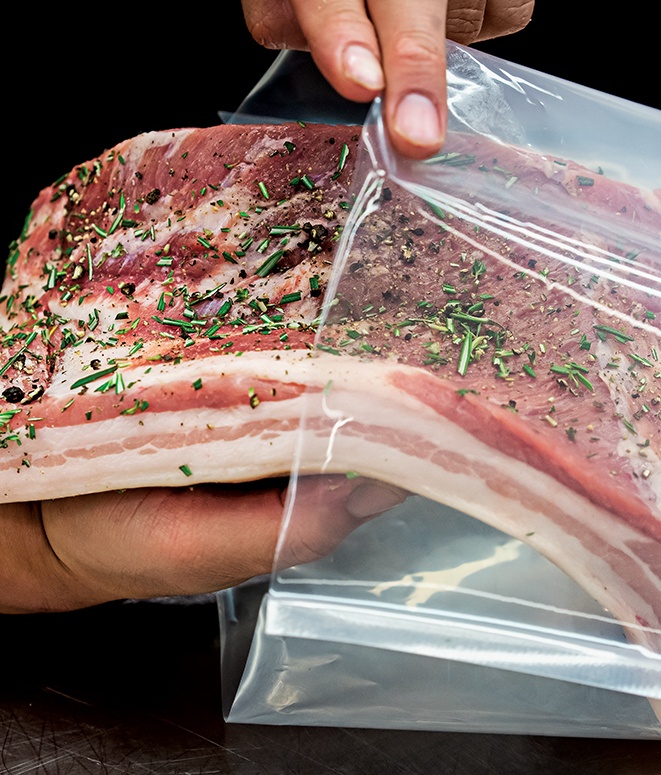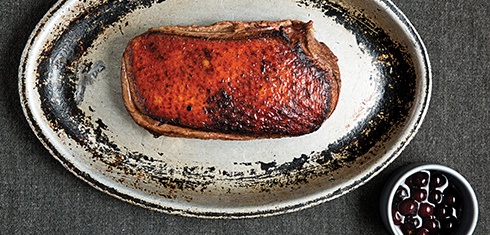By Naomi Tomky
Unboxing a brand-new sous vide machine is exciting—but sometimes, the rush to get started can lead to avoidable mistakes. These quick tips will help new sous vide cooks get a handle on some of the easily overlooked complications, and give even experienced chefs a reminder on the technique’s specific quirks.
DON’T:

LET THE WATER EVAPORATE.
Cooking in a container on your countertop instead of in a pot on the stove doesn’t mean the heat of cooking sous vide won’t evaporate the water. After you’ve set up your food in the water bath, cover the container using a custom-fit top, plastic wrap, or a layer of pingpong balls. If you add water, heat it first to the same temperature in a separate container so it doesn’t change the cooking temperature.

COOK MEAT BELOW 130˚F FOR A LONG PERIOD OF TIME.
Learning to cook meat low and slow can be addicting, and while it might seem like it’ll just get better and better the lower and slower you go, it’s best to keep it above 130˚F (54.4°C) for safety.

STORE RAW FOOD SOUS VIDE.
Sous vide pouches are specially designed to eliminate the transfer of oxygen, making the plastic bags perfect for cooking underwater. Raw sous vide food storage is not safe. Pack and refrigerate uncooked ingredients, and you can wind up with some funky food: Veggies will ferment more quickly, and raw meats and fish will end up with a shorter shelf life. Your best bet? Cook or freeze immediately after packing for safe and long-lasting results.
DO:

BAG EACH SERVING INDIVIDUALLY.
While it may seem tempting to throw a few fish filets or chicken breasts into a bag together, beware: The proteins will fuse together during the sous vide cooking process. If you’re just doing a quick and casual meal for yourself, this might not be an issue; but if you’re showing off some rib-eyes for dinner guests, you’ll want to bag each one individually in sous vide-safe bags.

CHILL FOOD QUICKLY.
When your dish is done cooking sous vide, you have three options: eat it, heat it, or chill it. Leaving food at a medium temperature—“the danger zone,” or 40˚F (4.4°C) to 140˚F (60°C)—allows bacteria to grow, so you’ll want to either eat your food right away, heat it (e.g. searing a steak post-cook), or chill it within two hours, finishing with an ice bath.
Related Articles VIEW MORE ARTICLES
Tips & Techniques
A Guide to Sous Vide Sauces
Every home chef should count these sous vide sauces among their kitchen secrets.
Read More >Tips & Techniques
How to Sous Vide: Octopus
The sous vide method is the ultimate secret weapon for transforming octopus into an impossibly tender, delicate dish.
Read More >Tips & Techniques
Getting Started with Sous Vide
Trying sous vide cooking for the first time? Get the scoop on how to do it right with helpful tips from the chefs at Cuisine Solutions, the world-renowned experts in the sous vide method.
Read More >Related RecipesView All Recipes
Sous Vide Flank Steak
 Beginner
BeginnerJuicy, flavorful, and perfectly done: Follow this sous vide flank steak recipe for red-meat nirvana.
Sous Vide Duck
 Beginner
BeginnerJuicy, faintly tart blueberry is a fitting counterpoint to rich, flavorful duck. Your taste buds will thank you.
Buy the Magazine
Buy NowDedicated to the Art & Science of Sous Vide
The first publication devoted to the art and science of sous vide cooking, featuring innovative recipes, visual inspiration, expert techniques for cooking sous vide at home, and exclusive interviews with world-class chefs.




